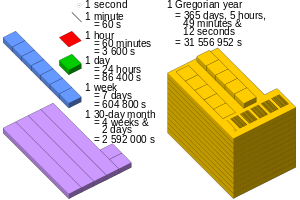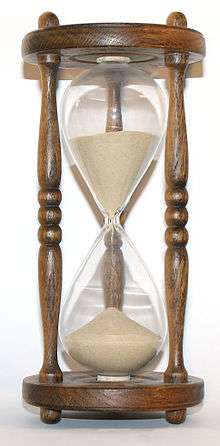Unit of time
A unit of time or midst unit is any particular time interval, used as a standard way of measuring or expressing duration. The base unit of time in the International System of Units (SI) and by extension most of the Western world, is the second, defined as about 9 billion oscillations of the caesium atom. The exact modern definition, from the National Institute of Standards and Technology is: "The duration of 9192631770 periods of the radiation corresponding to the transition between the two hyperfine levels of the ground state of the caesium-133 atom."[1]


Historically units of time were defined by the movements of astronomical objects.
- Sun-based: the year was the time for the earth to revolve around the sun. Year-based units include the olympiad (four years), the lustrum (five years), the indiction (15 years), the decade, the century, and the millennium.
- Moon-based: the month was based on the moon's orbital period around the earth.
- Earth-based: the time it took for the earth to rotate on its own axis, as observed on a sundial. Units originally derived from this base include the week at seven days, and the fortnight at 14 days. Subdivisions of the day include the hour (1/24 of a day), which was further subdivided into minutes and finally seconds. The second became the international standard unit (SI units) for science.
- Celestial sphere-based: as in sidereal time, where the apparent movement of the stars and constellations across the sky is used to calculate the length of a year.
These units do not have a consistent relationship with each other and require intercalation. For example, the year cannot be divided into 12 28-day months since 12 times 28 is 336, well short of 365. The lunar month (as defined by the moon's rotation) is not 28 days but 28.3 days. The year, defined in the Gregorian calendar as 365.2425 days has to be adjusted with leap days and leap seconds. Consequently, these units are now all defined as multiples of seconds.
Units of time based on orders of magnitude of the second include the nanosecond and the millisecond.
Historical
The natural units for timekeeping used by most historical societies are the day, the solar year and the lunation. Such calendars include the Sumerian, Egyptian, Chinese, Babylonian, ancient Athenian, Buddhist, Hindu, Islamic, Icelandic, Mayan, and French Republican calendars.
The modern calendar has its origins in the Roman calendar, which evolved into the Julian calendar, and then the Gregorian.
Scientific time units
- The jiffy is the amount of time light takes to travel one fermi (about the size of a nucleon) in a vacuum.
- Planck time is the time light takes to travel one Planck length. Theoretically, this is the smallest time measurement that will ever be possible. Smaller time units have no use in physics as we understand it today.
- The TU (for Time Unit) is a unit of time defined as 1024 µs for use in engineering.
- The Svedberg is a time unit used for sedimentation rates (usually of proteins). It is defined as 10−13 seconds (100 fs).
- The galactic year, based on the rotation of the galaxy, and usually measured in million years.[2]
- The geological time scale relates stratigraphy to time. The deep time of Earth’s past is divided into units according to events which took place in each period. For example, the boundary between the Cretaceous period and the Paleogene period is defined by the Cretaceous–Paleogene extinction event. The largest unit is the supereon, composed of eons. Eons are divided into eras, which are in turn divided into periods, epochs and ages. It is not a true mathematical unit, as all ages, epochs, periods, eras or eons don't have the same length; instead, their length is determined by the geological and historical events that define them individually.
Note: The light-year is not a unit of time, but a unit of length of about 9.5 petametres (9 454 254 955 488 kilometres).
List
| Unit | Length, Duration and Size | Notes |
|---|---|---|
| Planck time unit | 5.39×10−44 s | The amount of time light takes to travel one Planck length. Theoretically, this is the smallest time measurement that will ever be possible.[3] Smaller time units have no use in physics as we understand it today. |
| yoctosecond | 10−24 s | |
| jiffy (physics) | 3×10−24 s | The amount of time light takes to travel one fermi (about the size of a nucleon) in a vacuum. |
| zeptosecond | 10−21 s | Time measurement scale of the NIST strontium atomic clock. Smallest fragment of time currently measurable is 850 zeptoseconds.[3] |
| attosecond | 10−18 s | |
| femtosecond | 10−15 s | Pulse time on fastest lasers. |
| Svedberg | 10−13 s | Time unit used for sedimentation rates (usually of proteins). |
| picosecond | 10−12 s | |
| nanosecond | 10−9 s | Time for molecules to fluoresce. |
| shake | 10−8 s | 10 nanoseconds, also a casual term for a short period of time. |
| microsecond | 10−6 s | Symbol is µs |
| millisecond | 10−3 s | Shortest time unit used on stopwatches. |
| jiffy (electronics) | 1/60 s or 1/50 s | Used to measure the time between alternating power cycles. Also a casual term for a short period of time. |
| second | 1 s | SI Base unit. |
| decasecond | 10 s | |
| minute | 60 s | |
| moment | 1/40 solar hour (90 s on average) | Medieval unit of time used by astronomers to compute astronomical movements, length varies with the season.[4] |
| hectosecond | 100 s | 1 minute and 40 seconds |
| decaminute | 10 min | |
| ke | 14 min 24 s | Usually calculated as 15 minutes, similar to "quarter" as in "a quarter past six" (6:15). |
| kilosecond | 1000 s | 16 minutes and 40 seconds |
| hour | 60 min | |
| hectominute | 100 min | 1 hour and 40 minutes |
| kilominute | 1000 min | 16 hours and 40 minutes |
| day | 24 h | Longest unit used on stopwatches and countdowns. |
| week | 7 d | Also called "sennight". |
| megasecond | 106 s | 277.777778333333 hours or about 1 week and 4.6 days. |
| fortnight | 2 weeks | 14 days |
| lunar month | 27 d 4 h 48 min – 29 d 12 h | Various definitions of lunar month exist. |
| month | 28–31 d | Occasionally calculated as 30 days. |
| quarter and season | 3 mo | |
| semester | 18 weeks | A division of the academic year.[5] Literally "six months", also used in this sense. |
| year | 12 mo | 365 or 366 d |
| common year | 365 d | 52 weeks and 1 day. |
| tropical year | 365 d 5 h 48 min 45.216 s[6] | Average. |
| Gregorian year | 365 d 5 h 49 min 12 s | Average. |
| sidereal year | 365 d 6 h 9 min 9.7635456 s | |
| leap year | 366 d | 52 weeks and 2 d |
| biennium | 2 yr | |
| triennium | 3 yr | |
| quadrennium | 4 yr | |
| olympiad | 4 yr | |
| lustrum | 5 yr | |
| decade | 10 yr | |
| indiction | 15 yr | |
| gigasecond | 109 s | 16,666,666.6667 minutes or About 31.7 years. |
| jubilee | 50 yr | |
| century | 100 yr | |
| millennium | 1000 yr | Also called "kiloannum". |
| terasecond | 1012 s | about 31,700 years. |
| Megannum | 106 yr | Also called "Megayear." About 1,000 millennia (plural of millennium), or 1 million years. |
| petasecond | 1015 s | About 31,700,000 years or 380,399,583.12 months |
| galactic year | 2.3×108 yr[2] | The amount of time it takes the Solar System to orbit the center of the Milky Way Galaxy one time. |
| cosmological decade | varies | 10 times the length of the previous cosmological decade, with CÐ 1 beginning either 10 seconds or 10 years after the Big Bang, depending on the definition. |
| aeon | 109 yr | Also spelled "eon". Also refers to an indefinite period of time. |
| exasecond | 1018 s | About 31,700,000,000 years or 380,399,583,123.74 months |
| zettasecond | 1021 s | About 31.7 trillion years or 3,803,995,983,123,744.56 months |
| yottasecond | 1024 s | About 31.7 quadrillion years or 380,399,583,123,744,510 months |
Units of time interrelated

All of the formal units of time are scaled multiples of each other. The most common units are the second, defined in terms of an atomic process; the day, an integral multiple of seconds; and the year, usually 365 days. The other units used are multiples or divisions of these three.
References
- "Definitions of the SI base units". The NIST reference on Constants, Units, and Uncertainty. National Institute of Standards and Technology. Retrieved 4 March 2016.
- http://starchild.gsfc.nasa.gov/docs/StarChild/questions/question18.html NASA - StarChild Question of the Month for February 2000
- "It only takes a zeptosecond: Scientists measure smallest fragment of time". RT International. Retrieved 2017-04-20.
- Milham, Willis I. (1945). Time and Timekeepers. New York: MacMillan. p. 190. ISBN 0-7808-0008-7.
- "Semester". Webster's Dictionary. Retrieved 3 December 2014.
- McCarthy, Dennis D.; Seidelmann, P. Kenneth (2009). Time: from Earth rotation to atomic physics. Wiley-VCH. p. 18. ISBN 3-527-40780-4., Extract of page 18


